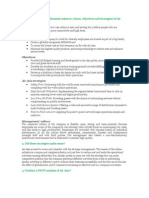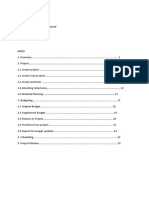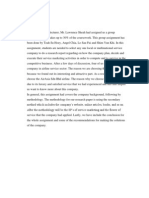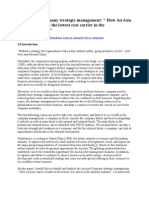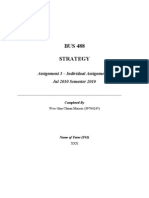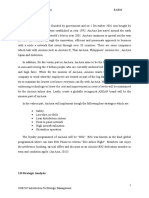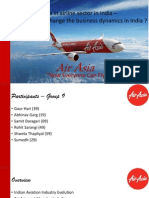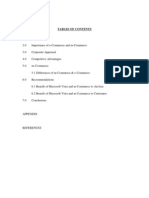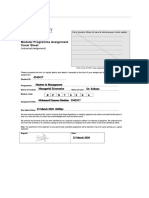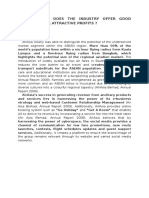Air Asia
Air Asia
Uploaded by
Mohd Mazhan Kaya AminCopyright:
Available Formats
Air Asia
Air Asia
Uploaded by
Mohd Mazhan Kaya AminOriginal Description:
Copyright
Available Formats
Share this document
Did you find this document useful?
Is this content inappropriate?
Copyright:
Available Formats
Air Asia
Air Asia
Uploaded by
Mohd Mazhan Kaya AminCopyright:
Available Formats
Sunday, April 1, 2012
Strategic Planning Analysis Involving the Current Strategic Positioning Of Air Asia
This is my first assignment for my MBA programme, it took me a lot of time, effort and hard work to complete this paper, it isn't perfect but its mine. I am posting this in my blog as a reference and guidance for others. Now, i am not asking you not to copy, feel free to use or republish any parts of this paper, but please do have a link of the source back to this site. I hope you will, as some papers are being sold at a hefty price, i am publishing this for free with a simple request, acknowledgement. Cheers, Viknesh Rajandran
Executive Summary
AirAsia was established in 1993 and the operations began in 1996. AirAsia had rather a shaky start and the 1997-1998 Financial crisis had further worsen the situation for Asia to grow as a low cost carrier. During it dire stage, the company was taken over by Tune Air under the leadership of Dato Tony Fernandes with the help of Conor McCarthy, former Director of Group Operations, Ryanair. Based on Southwest Airlines and Ryanairs business model, AirAsia offer No frills airlines with a catchy tagline of Now Everybody Can Fly. Within 2 years AirAsia posted a net income of 18.8 million and broke the 100 million net income barriers in 2005. Since then nothing has stopped AirAsia from moving forward and setting milestones, notably the first Asian Airlines to go ticketless in 2002, first multi lingual Asian airlines website in 2003 and the worlds first airline to launch a mobile site. All these are aligned with AirAsias philosophy to make flying affordable, easy and convenient. Having flown 100 millions guests AirAsia has been in the spotlights for all the rights reason, for aggressive marketing, for awards and achievements. The paper shows internal and external analysis of AirAsia. This paper intends to analyze the Strategic Planning of AirAsia An in depth study has been done on its strength and weaknesses of current strategies and core competence. After evaluating the industry and AirAsia, it is concluded that for AirAsia to maintain its market position as the leader of low cost flight operator, AirAsia should offer more routes and expands its product portfolio. AirAsias brand
vision is to maintain its leadership in the region towards the development of brand strategy and other financial and operational goals.
Table of Content
No 1.0 2.0 2.1 3.0 3.1 3.2 4.0 4.1 4.2 4.3 4.4 5.0 Title Introduction to Strategic Management Introduction of Company AirAsias Business Model External Analysis Pest Analysis Michael Porters Five Competitive Forces Internal Analysis Swot Analysis Tows Matrix Value Chain Analysis Implications Of Current Strategy Strategic Objectives Page
5.1 5.2 6.0 6.1 6.2 7.0 7.1 7.2 8.0 8.1 8.2 8.3 8.4 8.5 8.6 8.7 8.8 8.9 8.10 8.11 8.12 9.0
Online Marketing Increase Product Offering Corporate Strategy BCG Matrix Competitive Profile Matrix Business Level Strategy Ansoff Matrix Porters Generic Appendix AirAsia Routes AirAsia Strategies Jet Fuel Price Movement Over Past 5 Years Jet Fuel Price Over Past 6 Months Malaysia's demographic and economic indicators Malaysian GDP for 10 years AirAsias Award for the last 3 years KLIA2 Passenger Traffic Forecast. AirAsia Financial Report 2010 BCG Matrix Ansoff Matrix Porters Generic References
1.0 Introduction to Strategic Management
Strategic Management which also known as Strategic Planning can be defined as the art and science of formulating, implementing, and evaluating cross-functional decisions that enable an organization to achieve its objectives. As this definition implies, strategic management focuses on integrating management, marketing, finance or accounting, production or operations, research and development, and information systems to achieve organizational success (Davis, 2011). Strategic Planning helps an organization to explore and create new opportunities as a goal while delivering tomorrows offering today. It gives an organization a long term direction in the scope of the organization activity while gaining advantage over competitors. The strategic management field can be conceptualized as one centred on problems relating to the creation and sustainability of competitive advantage, or the pursuit of rents (Bowman et al, 2002) Strategy is more about building relationship rather than beating the competition, it focuses on strategic and operational elements of internal and external environments and uses the advantages of the organization to excel in its business. A Companys strategy is a work in progress and changes may be necessary to react to competitors strategy, customers need and wants, technological
factors, market condition and during crisis. Gregory (2005) argues that a company with a good strategy must make clear choices about what it wants to accomplish. Doing everything that your rivals do eventually leads to mutually destructive price competition, not long-term advantage.
2.0 Introduction of Company
Tune Air Sdn Bhd was founded in 2001 by Dato Sri Tony Fernandes and Dato Kamarudin Meranun. The duo bought Air Asia for RM1.00 with a RM40 million debt. (AirAsia, 2011). The airline grew from a fleet of 2 aircrafts to 72. AirAsia believes in no-frills, hassle-free, low fare business concept and feels that keeping costs low requires high efficiency in every part of the business. The Companys vision is to be the largest low cost airlines in Asia and serving 3 billion people who are currently underserved with poor connectivity and high fares. AirAsia s mission is to be the best company to work for whereby employees are treated as a part of a big family, create a globally recognized ASEAN brand, to attain the lowest cost so that everyone can fly with AirAsia, maintain the highest quality product, embracing technology to reduce cost and enhance service levels. As shown in Appendix 1 Asias leading and largest low cost carrier flies over 20 countries with 400 flights daily to over 70 destinations (AirAsia, 2012a). AirAsia makes the low fare model possible through the following key strategies and values as in Appendix 2. AirAsias business strategy focuses on cost leadership aligned to its vision. AirAsia X was
established in 2007 and it focuses on the long-haul non- stop straight flight while still holding on to low-cost business model connecting Australia, New Zealand, China, Taiwan, Korea and India (AirAsia, 2012a). In 2010, AirAsia, establishes AirAsia Thailand and AirAsia Indonesia and was setting up AirAsia Philippine. AirAsias latest financial statements records a group revenue of Rm 3.95 billion and Rm1.06 billion profit after tax with a total assets of Rm 13.24 billion (AirAsia, 2010a) 2.1 AirAsias Business Model AirAsia is the market leader in cost leadership by maintaining 6 key components of Low Cost Carrie model. AirAsia practices high aircraft utilization. Its aircraft is airborne 12 hours per day compared to 8 hours by a full board carrier. No frills simply mean eliminating all the luxury and non essential offerings, for example baggage, snacks, seat allocation can still be acquired for a small fee. AirAsia streamlines its operation to single line of fleet and seating. There is no Business class or lounges and AirAsia flies to secondary airport to reduce as its cheaper and faster turnaround time as less traffic. AirAsia embraces Point to point network means there is no stop-over or connecting flights. AirAsias lean distribution system focuses on internet sales as its the most effective way and cuts the commission paid to agents or reservation channels. (AirAsia, 2012b)
3.0 External Analysis
3.1 PEST Analysis 3.1.1 Political Factor Malaysia Airlines is 69% owned by the government and has been protected on the routes that are offered (BBC, 2006). Incheon, Singapore and Sydney routes are protected for Malaysia Airlines. Malaysian Airlines will convert its low fare airlines, Firefly to a full board airline to protect AirAsia. (BBC, 2011) 3.1.2 Economical Factor Appendix 3 shows the jet fuel price per barrel over the last 5 years, the charts most noticeable feature will be the price fluctuation. The charts shows a dramatic price drop in November 2008
and an inclining price hike ever since. Even though Appendix 4 shows a stable fuel price over the last six months, the fuel price remains unpredictable but the new Airbus 320 Neo will be able to save 15 % fuel with additional 950 Kilometres or to transport 2 tonnes of additional weight (Airbus, 2011). High taxes, visa restrictions and baggage handling charges are increasing for Europe and India Destinations (BBC, 2012). Annual disposable income of Malaysia has seen great improvements in year 2010 and 2011as seen in Appendix 5 3.1.3 Social Factor Malaysia GDP per capita in Appendix 6 shows a positive growth in 10 years with a slight decline in year 2010. An Average Malaysian tourist spends about USD 4,700 during their stay and is amongst the highest repeat visitor to Australia. Malaysian tourists expenditure to New South Wales from Malaysia grossed at USD 142 million, which is a 75% increase from 2010 (Travel Weekly Asia, 2012). 3.1.4 Technological Factor Airbus 320 Neo will incorporate new Leap-X engine from CFM International and larger wing tips called sharklets. This new fleets will deliver fuel savings of 15% and range capability of 500 nautical miles. (Airbus, 2011) 3.2 Michael Porters Five Competitive Forces Table 1
. Source: Strategic Management By Fred Davis Chapter 3
3.2.1 Bargaining Power of Suppliers The bargaining power of suppliers in the airlines is high as the aviation industry faces a duopoly hence the price is determined by Airbus and Boeing. 3.2.2 Bargaining Power of Buyers
There is no cost of switching for the customers to use another services or product. The access of internet connectivity has made it very easy for customers to compare prices of flight before making changes. For a full board airline, customers will be more demanding but willing to pay more in contrary to the bigger market demands for low cost airlines, the customers are less demanding but thrifty. 3.2.3 Threat of Substitute Product or Services Substitute for the products offered by AirAsia will be trains, buses and cruise, however due to the geographical factor trains buses and cruises are not viable. For business travellers telecommunication and video conferencing is also seen as a substitute here. Cisco Webex offers unlimited meeting as low as USD 19 per month (Cisco, 2012). The threat of substitute here is moderate. 3.2.4 Threat of New Entrants When it comes to the Airlines industry in Malaysia, threat of new entrant is very low. This is due to high operating cost, government regulation and legislation. Moreover, AirAsias brand awareness and market leadership will put AirAsia ahead of the competition. Even though there is freedom of entry and exit the airlines industry has seen many flight operator went out of business, namely AdamAir, Cosmic Air, Impulse Airlines and Oasis Hong Kong. (Asia Times, 2007) 3.2.5 Rivalry among Existing Competitors AirAsias main rival was Malaysian Airlines and its low cost airlines Firefly. But since August 2011 agreement between AirAsia and Malaysia Airlines, firefly will no longer be a rival to AirAsia as Firefly will be a full board Airlines and Malaysian Airlines will focus on its strength and will not directly compete with AirAsia.
4.0 Internal Analysis
4.1 SWOT Analysis Table 2 AirAsia SWOT Analysis Strengths
1. Low cost operations 2. Simple proven business model 3. Single fleet of aircraft 4. Multi-currency online sales 5. Partnership with Expedia 6. Quick turnaround time 7. World's best low cost airlines 2009-2011by Skytrax
Weakness
1. Secondary airports locations 2. No customer service toll free line 3. Limited Aircrafts 4. Website downtime and error 5. Flight delays
Opportunities
1. Adding more routes in North Asia 2. Partnership with travel agents for ground arrangements 1. Increasing fuel prices 2. Terrorist attacks
Threats
3. 200 new units of A320 neo aircraft in 2016 4. MAS cutting flights to certain destination
3. Aviation rules and Government policies 4. Firefly offering baggage 5. Firefly offering in flight drinks and snacks
4.1.1 Strength AirAsia serves a very basic need of its passenger, getting from point A to point B, its business models derives from Southwest Airlines, Ryanair and EasyJet. AirAsias No Frills module simply means cutting out the unnecessary offering such as in-flight meals, baggage allowance, lesser leg room and reduced seat pitch. The storage space for food has been used to add more seats. And by no free snacks means lesser time spent on the ground and AirAsia spend nothing more than 25 minutes on the ground each time it lands. Averagely a full board airline is airborne for 8-9 hours a day while AirAsia flight is airborne for 12 hours a day. By using the same fleet, AirAsia reduces the cost of training cabin crews and pilots as it is easier to move them around and the floor plan and layout remains the same. The official website of AirAsia, allows you to pay using multiple currency options and with the partnership of Expedia, AirAsia website serves as the only website a passenger need to book a flight, accommodation and ground arrangements. AirAsia has won the prestigious award Worlds Best Low Cost Airlines by Skytrax for the last 3 consecutive years (AirAsia, 2012c), Appendix 7 shows the award won by AirAsia for the last 3 years and it certainly helps build trust in the brand. 4.1.2 Weakness According to a research, 35% of passengers choose airlines based on punctuality (Emirates247, 2008) by delaying flight AirAsia also loses its air borne time. Another problem that AirAsia faces is the customer service support and there is only 2 ways for one to get in touch with an AirAsia customer service representative, either by writing to their customer service e-mail mailbox with a reply response lead time of 4-5 days or a premium customer service line with a charge of RM 1.95 per minute (AirAsia, 2012e). There also have been incidents whereby AirAsia website is down, most of the time during its promotions and most probably due to heavy traffic and non redundant data infrastructure. As cost rises and consumers expects to pay lesser AirAsia routes its flights to secondary airports as the handling fees and airport charges are lower. 4.1.3 Opportunities As the flight to Europe and India has been called off, AirAsia focuses to open more routes in North Asia. With new fleets AirAsia should open more routes such as Palawan, Boracay, Makati, Koh Sa Mui and Madurai. MAS has also confirmed that it will reduce its flight frequency to Sydney and Fireflys routes to Langkawi, Penang and Singapore post August 2011 agreement to benefit AirAsia (The Star, 2012b) 4.1.4 Threats Events such as Bali bombing, 9/11 and Bangkok Airport lockdown are unpredictable potential treats. Aviation rules and government policies also act as a threat and in this case, AirAsia faces fuel price hike, airport tax, handling charges and government protection towards national carrier and predominant route restrictions.
4.2 TOWS Matrix Table 3
4.2.1 SO Strategies Malaysian Airport Holdings Berhad has announced that KLIA2, the new low-cost carrier terminal will be ready by April 2013 (Sidhu, 2011) AirAsia asked for bigger KLIA (Yee, 2012).
It is estimated that passenger traffic at KLIA2 alone would hit 28.7 million by 2015, 45.3 million by 2020 and 60.3 million by 2025 as seen in Appendix 8. 4.2.2 WO Strategies By expending AirAsias fleet, AirAsia will be able to offer more routes to its customers, one of the routes that will excites the passengers will be Koh Sa Mui, as for now Firefly dominates the route there and dictates the price of air fare. Both AirAsias social media, Twitter and Facebook has numerous complain about being unable to reach customer service and delayed email response. Air Asia can choose to switch their premium call centre and outsource their call centre to a 3rd party company and instead of charging RM1.95 per minute, AirAsia may charge normal Telco tariff charges. Outsourcing these services means overheads, but there is also a way around it, instead of a customer service hotline, the same toll free number may be used as a online booking and reservation line.
4.2.3 ST Strategies With the average fuel price increased by 36% over the year, the fuel cost makes 50% percent of AirAsias operating cost, (The Star, 2012a) and by switching to the A320 Neo Airbus with LEAP engine; Air Asia will have additional 500 nautical miles and 15% fuel savings. (Airbus, 2011). AirAsia charges its customers when they opt for seat allocation. Air Asia can still continue the charges for seat allocation but, an incentive should be given to customer who does a group booking with minimum of 10 pax at a time or for customers who book in advance from 10 months ahead. This will help in customer retention and to bring customer from Firefly, as satisfied customer are more likely to buy additional products, loyal, less influenced by competitor and less price sensitive. (Zineldin, 2000)
4.2.4 WT Strategies There has been instance where AirAsias website is down due to busy traffic or for scheduled maintenance. As 77% of AirAsias sales derive from online booking (AirAsia, 2010a), AirAsia cannot afford to have a downtime. The best value solution is to have its direct sales engine service provider, Navitaire to set up disaster recovery plant, or a high availability solution for its web servers. AirAsia also could offer its passenger who flies above 4 hours to have a free 15kg baggage allowance. Even though this will be contradicting with AirAsias No Frills policy, on a bigger scale it ensures loyalty and most importantly customer retention.
4.3 Value Chain Analysis Table 4
Legend CRS FSS YMS DBM IS CC
: Computer Reservation System : Flight Scheduling System : Yield Management System : Database Marketing : Internet Sales : Call Center
Table 4 shows AirAsias Value Chain analysis based on Porters Value Chain. Table 4 shows list of significant activities to drive business continuity of AirAsia as market leader of Low Cost Carrier. By using single fleet of aircraft AirAsia reduces cost of maintain the plane reducing flight delay and turnaround time. Ground crew are well equipped, air crews are trained to multitask and AirAsia has its own academy to train pilots. With its current marketing and promotions, AirAsia will succeed by introducing more products and routes. And Finally AirAsia has to improve on its lead time to reach to customer in the event of complaints and inquiry 4.4 Implications Of Current Strategy After studying both the internal and external analysis of AirAsia, If AirAsia continues with its current strategy, it will remain profitable for a short term with new cost savvy airplanes and focusing on cost leadership. But AirAsia will not grow unless its addresses customers pain point and diversify its offering.
5.0 Strategic Objectives.
AirAsias promotions are very well received by the consumer for example its Free Seat Promotion and Mega Sale Promotion. In order for AirAsia to maintain its profitability and ensure its stays in line with cost leadership business model, AirAsia has to offer more routes and products in its portfolio. Association of Asia Pacific Airlines stated that demand for air travel is projected to grow 5% annually, with the Asia Pacific region expanding at an even faster pace of 6% per annum over the next twenty years (AAPA, 2011). More routes and fleets mean more customers and potential ancillary income, in 2010 ancillary income per guest is RM 44 (AirAsia 2010a). Air Asia should also strongly focus on its offering via web booking as 77% of its revenue derives via internet (Appendix 9). To further proof this, during AirAsias Mind Blowing Fare, 538,000 tickets were sold in 24 hours and a record setting 36,871ticket per hour. (AirAsia 2010a) 5.1 Online Marketing Social media is a very powerful tool, in a recent survey by TNS, Malaysians have the most number of friends in social networking websites and spends 9 hours a weekly. (The Star, 2010). But in total, on average a Malaysian spends 19 hours and 48 minutes online whereby 54% of them are spent purchasing online, and a 46% trust the source obtained online. 94% of Malaysian uses social networking sites as shopping guidelines and 45% of them share their experience on their product, brand or experience. (Nielsen, 2010) AirAsia should continue to carry its promotions and focus even more on online marketing and selling. Social medias are mostly free
and AirAsia should leverage on these platforms to market its product and also use it a medium to collect feedback. However, AirAsia should also be mindful as negative comments and bad customer experience will also be posted on the same platform and it is visible to everybody. AirAsia has to be tactful in handling these situations.
5.2 Increase Product Offering By partnering with Expedia, AirAsia adds value to its services by easing travellers to book accommodation and ground arrangements. AirAsia should work with more partners to obtain a better price so that its customer will be able to get better deals. Agoda, Booking.com, Wotif and Orbitz are a few other options for AirAsia to work with on accommodation. As for tour packages and ground arrangements, AirAsia should form collaboration with local partners, for example Reliance and Berjaya Holidays. These arrangements with local travel agents will also benefit AirAsia as they may set a quota or have an agreement with the local tour agents to use AirAsias services. AirAsia should also focus on new routes, for example, domestic flights within Thailand, Australia and India, respectively 34 %, 49% and 59% of all flight are domestic flights (Forbes, 2010)
6.0 Corporate Strategy
6.1 BCG Matrix Appendix 10 shows the BCG Matrix for AirAsia. AirAsia began its operation in 1996 and was in the Dog quadrant until it was bought in 2001by Tune Group, it then moved to the Question Mark quadrant as its growth was still unpredictable (AirAsia, 2011). Over the years AirAsia has proven that it is in the STAR quadrant and AirAsia has to diversify its offerings to keep itself in this quadrant as to ensure healthy revenue. 6.2 Competitive Profile Matrix Table 5
AirAsia Critical Success Factors Advertising & Promotion Weighted Weight Rating Score 0.10 4 0.40 MAS Weighted Rating Score 3 0.30 Firefly Weighted Rating Score 2 0.20
Quality Of Service Price Competitiveness Destinations Comfort Security On Schedule take off Competitiveness Customer Loyalty Market Share Reward Programs
0.15 0.10 0.10 0.09 0.05 0.08 0.10 0.10 0.08 0.05 1.00
2 4 2 2 3 3 4 3 4 4
0.30 0.40 0.20 0.18 0.15 0.24 0.40 0.30 0.32 0.20 3.09
3 1 4 4 3 4 3 3 4 3
0.45 0.10 0.40 0.36 0.15 0.32 0.30 0.30 0.32 0.15 3.15
2 3 1 2 3 3 2 2 1 1
0.30 0.30 0.10 0.18 0.15 0.24 0.20 0.20 0.08 0.05 2.00
Table 5 shows the Competitive Profile Matrix of AirAsia, Mas and Firefly. AirAsia outperformed Firefly in every critical success factor hence Firefly is not a threat to AirAsia. MAS on the other hand scored 3.15, just 0.06 point ahead of AirAsia. AirAsia fared reasonably in this CPM, taking into consideration that it is a low cost carrier compared to MAS, a full board carrier. AirAsia will need to improve in its quality of service and on the destination offered. Failing to do so, the implications will be, customer opting to pay more and fly MAS due to poor service and losing the market of untapped routes to MAS.
7.0 Business Level Strategy
7.1 Ansoff Matrix Appendix 11 shows the Ansoff Matrix, and AirAsia must focus on Market diversification to maintain its profitability and for it to expand. The product offered must be developed to meet markets demand and to address changing market conditions. The suggestion given to AirAsia is to offer more routes and also to offer tour packages.
7.2 Porters Generic Appendix 12 shows the Porters Generic Competitive Strategy. AirAsia has chosen cost leadership, and it is indeed the most affordable low cost carrier in its industry, the source of its advantage is fuel hedging, purchasing new fuel efficient A320 Neo Airbus and simple business model. AirAsia builds and grows its competitive advantage by providing products and services at a price lower than its competitors. By focusing on cost leadership, AirAsia indirectly serves the low income markets and as stated by (Prahalad, 2002) low income market presents a
prodigious opportunity for the worlds wealthiest companies to seek their fortunes and bring prosperity to the aspiring poor. He also mentioned that two-thirds of the world population falls under this category and their annual per capita income based on purchasing power parity in USD is less than 1500.00.
8.0 Appendix
Appendix 1 AirAsia Routes Source: http://www.airasia.com/my/en/flightinfo/routemap.page
Appendix 2 AirAsia Strategies Source: http://www.airasia.com/my/en/corporate/corporateprofile.page
Partnering with the worlds most renowned maintenance providers and complying with the with world airline operations. Implementing the regions fastest turnaround time at only 25 minutes, assuring lower costs and higher productivity. Providing guests with the choice of customizing services without compromising on quality and services. Making sure that processes are as simple as possible. Offering a wide and innovative range of distribution channels to make booking and travelling easier. Applying the point-to-point network keeps operations simple and costs low
Safety First High Aircraft Utilization Low Fare, No Frills Streamline Operations Lean Distribution System Point to Point Network
Appendix 3 Jet Fuel Price Movement over Past 5 Years Source: http://www.iata.org/whatwedo/economics/fuel_monitor/Pages/price_development.aspx
Appendix 4 Jet Fuel Price over Past 6 Months Source: http://www.iata.org/whatwedo/economics/fuel_monitor/Pages/price_development.aspx
Appendix 5 Malaysia's demographic and economic indicators Source: http://www.euromonitor.com/malaysia/country-factfile
Appendix 6 Malaysian GDP for 10 years Source: http://www.tradingeconomics.com/malaysia/gdp-per-capita-ppp
Appendix 7 AirAsias Award for the last 3 years Source: http://www.airasia.com/vn/en/corporate/awards.page
Awards Worlds Best Low Cost Airline Best Low Cost Airline Asia Best Company for Investor Relations Mid Cap Best Investor Relations Website Mid Cap Asias Best Low Cost Cargo Carrier Award Fastest Growing Foreign Airline for Cargo 010 Asiamoneys Best Managed Company Award Masterclass Global CEO of the Year Worlds Best Low Cost Airline Air Cargo Industry Newcomer Award Airline Of The Year Frost & Sullivan Excellence in Leadership Award Best Asian Low-Cost Carrier World's Best Low Cost Airline
Presented By Skytrax Skytrax Malaysian Investor Relations Associations (MIRA) Malaysian Investor Relations Associations (MIRA) Aviation Awards Asia 2011 Guangzhou Baiyun International Airport AsiaMoney Malaysia Business Leadership Award Skytrax Air Cargo Week Centre for Asia Pacific Aviation (CAPA) Frost & Sullivan TTG Travel Awards 2009 Skytrax
2011
2010
2009
Appendix 8 KLIA2 Passenger Traffic Forecast. Source : http://www.malaysiaairports.com.my/images/pressreleaseonklia2.pdf
Appendix 9 AirAsia Group Financial Highlights AirAsia Financial Report 2010 Source: http://www.airasia.com/iwov-resources/my/common/pdf/AirAsia/IR/AirAsia_AR10.pdf
Appendix 10 BCG Matrix
Source: Exploring Corporate Strategy by Johnson and Scholes Chapter 7
High Question Mark Market Growth Dogs Low Low Market Share High Cash Cows Stars
Appendix 11 Ansoff Matrix Source: Exploring Corporate Strategy by Johnson and Scholes Chapter 7
Products Present Present Market New Market Development Market Diversification Market Penetration New Product Development
Appendix 12 Porters Generic Source: Strategic Management by Fred Davis Chapter 5
Broad Competitive Scope Narrow
Cost Leadership
Differentiation
Cost Focus
Differentiation Focus
Competitive Advantage
You might also like
- Strategic Management AirAsiaDocument60 pagesStrategic Management AirAsiahai_maui810% (1)
- The Strategic Management of Airasia Tune GroupDocument6 pagesThe Strategic Management of Airasia Tune GroupJuni LinNo ratings yet
- Organizational Development GroupDocument23 pagesOrganizational Development GroupAliah Afiqah100% (3)
- Air AsiaDocument19 pagesAir AsiaAsfatin AmranNo ratings yet
- Air Asia Marketing MixDocument8 pagesAir Asia Marketing MixAnonymous B6yEOYI50% (2)
- Air Asia Case StudyDocument8 pagesAir Asia Case StudyLaila Al-Alawi80% (5)
- Airasia: Now Everyone Can FlyDocument13 pagesAirasia: Now Everyone Can FlyHammad Gillani100% (1)
- Strategic Analysis On AirAsiaDocument31 pagesStrategic Analysis On AirAsiallyida100% (1)
- Management Air AsiaDocument19 pagesManagement Air AsiaPrisy ChooNo ratings yet
- Strategic Management AirAsiaDocument62 pagesStrategic Management AirAsiaHusaini Selamat100% (5)
- Management AirasiaDocument18 pagesManagement AirasiaFarah WahidaNo ratings yet
- Air Asia StrategyDocument15 pagesAir Asia StrategyHenry Teepoh25% (4)
- PS User ManualDocument49 pagesPS User ManualSridhar Vc100% (1)
- Cost Plus Agreement-62Pages PDFDocument62 pagesCost Plus Agreement-62Pages PDFyakarim0% (1)
- Internship Report On Al-Arafah Islami Bank Ltd.Document51 pagesInternship Report On Al-Arafah Islami Bank Ltd.SazzadHossain83% (12)
- Air AsiaDocument25 pagesAir AsiaCeline SuHuiNo ratings yet
- Air Asia Case StudyDocument14 pagesAir Asia Case StudySofi JailaniNo ratings yet
- Business Strategy Air AsiaDocument3 pagesBusiness Strategy Air Asiahelmiwell100% (3)
- The AirAsia Company Strategic ManagementDocument13 pagesThe AirAsia Company Strategic ManagementNur Zara100% (1)
- Strategic Analysis On AirAsiaDocument31 pagesStrategic Analysis On AirAsiaWooGimChuan83% (12)
- Introduction To Strateic Management AirADocument19 pagesIntroduction To Strateic Management AirAMani SelvanNo ratings yet
- Air Asia MKTDocument9 pagesAir Asia MKTnurul hashimaNo ratings yet
- Air AsiaDocument32 pagesAir AsiaLittle FaithNo ratings yet
- Air AsiaDocument14 pagesAir AsiaFaiz AlwiNo ratings yet
- Air Asia-Diversification & Growth PlanDocument10 pagesAir Asia-Diversification & Growth PlanSagarica BrahmaNo ratings yet
- Imr451 - AirasiaDocument58 pagesImr451 - AirasiaAzz Izumi100% (1)
- AirAsia IndiaDocument7 pagesAirAsia Indiaarshdeep1990No ratings yet
- 1.0 Executive Summary:: Integrated Marketing CommunicationDocument28 pages1.0 Executive Summary:: Integrated Marketing CommunicationAnubhov Jobair100% (1)
- AirAsia's Corporate StrategyDocument1 pageAirAsia's Corporate Strategyraja athirahNo ratings yet
- Analysis of Leadership From Competency Perspective 1. Motivation For LeadershipDocument6 pagesAnalysis of Leadership From Competency Perspective 1. Motivation For LeadershipKavitha VallathNo ratings yet
- Air Asia India - x1Document11 pagesAir Asia India - x1arshdeep1990100% (1)
- AirAsia SlidesDocument9 pagesAirAsia SlidesjaysonchammbaNo ratings yet
- Air Asia - Case StudyDocument4 pagesAir Asia - Case StudyMohsin WaheedNo ratings yet
- AirAsia Case Study Report1Document5 pagesAirAsia Case Study Report1Muhammad IbrahimNo ratings yet
- Case Study Air AsiaDocument8 pagesCase Study Air AsiaAmzar Rahim100% (1)
- Malaysia Airlines Business PlanDocument44 pagesMalaysia Airlines Business Planmamamialezatos100% (1)
- Strategic Management at Air AsiaDocument9 pagesStrategic Management at Air Asiazeeshan100% (1)
- DMB AirAsia Core Competencies DistinctiveDocument34 pagesDMB AirAsia Core Competencies Distinctiveheda kalenia100% (1)
- AIR Asia Assignment MasterDocument58 pagesAIR Asia Assignment MasterZakuan AeuUniversity100% (5)
- AirAsia India Economic ProspectsDocument28 pagesAirAsia India Economic ProspectsKr SimantNo ratings yet
- Air AsiaDocument33 pagesAir AsiaJain05No ratings yet
- AIRASIA - The Low Cost CarrierDocument8 pagesAIRASIA - The Low Cost CarriersyfaisalNo ratings yet
- Air Asia Strategic AnalysisDocument28 pagesAir Asia Strategic AnalysisR. Iwan Budhiarta80% (20)
- Air AsiaDocument58 pagesAir AsiaFarahin Zainal100% (6)
- Air Asia Strategic ManagementDocument2 pagesAir Asia Strategic ManagementAffizul AzuwarNo ratings yet
- E Commerce - AirAsiaDocument25 pagesE Commerce - AirAsiakhormm100% (3)
- Strategic Management Airasia Strategic MDocument26 pagesStrategic Management Airasia Strategic MShariful islamNo ratings yet
- Airasia Marketing PlanDocument26 pagesAirasia Marketing Planfirinaluvina71% (7)
- Organizational BehaviourDocument17 pagesOrganizational BehaviourSureshNo ratings yet
- Air Asia MejikDocument13 pagesAir Asia MejikNunik Fajrinaa PutriNo ratings yet
- MGT 420 423 FinalDocument47 pagesMGT 420 423 FinalCeline SuHui100% (2)
- Chin Chin New - International Strategic ManagementDocument10 pagesChin Chin New - International Strategic Managementhsu myamonNo ratings yet
- Journal - FRM Taylor-LibreDocument8 pagesJournal - FRM Taylor-LibreG Kaviyarasan GovindanNo ratings yet
- Assignment Subject: Strategic Airline Marketing and CRM: Banasthali VidyapithDocument13 pagesAssignment Subject: Strategic Airline Marketing and CRM: Banasthali VidyapithPrashant MahawarNo ratings yet
- Information and Competitive AdvantagesDocument3 pagesInformation and Competitive AdvantagesSabbir Matin ArnobNo ratings yet
- Me ReportDocument10 pagesMe ReportAnjali AnantaNo ratings yet
- AirAsia Berhad - PESTLE Analysis of The Low Cost Carrier in The AsiaDocument8 pagesAirAsia Berhad - PESTLE Analysis of The Low Cost Carrier in The Asiahanwei_8650% (2)
- Managerial Economics - AirAsiaDocument15 pagesManagerial Economics - AirAsiaHamyz Eburahim100% (1)
- Bagianku CH 3Document6 pagesBagianku CH 3Cynthia AdiantiNo ratings yet
- DocumentDocument14 pagesDocumentLiu YuXinNo ratings yet
- Air AsiaDocument14 pagesAir Asiaroslizah3237868No ratings yet
- Strategic Management - THE AIR ASIA STORY & CORE COMPETENCIESDocument7 pagesStrategic Management - THE AIR ASIA STORY & CORE COMPETENCIESNoor Hairulnizam NasirNo ratings yet
- Air AsiaDocument15 pagesAir AsiaSuresh Samarasinhe100% (5)
- Case Study 3 - Confined SpaceDocument4 pagesCase Study 3 - Confined Spaceaswin vargheseNo ratings yet
- NPA BookletDocument13 pagesNPA BookletBaidehee100% (2)
- Customers Satisfactionofbsnl ServicesDocument11 pagesCustomers Satisfactionofbsnl Servicesnira007No ratings yet
- M.R.S. ENTERPRISES, INC. v.SHEET METAL WORKERS INTERNATIONAL ASSOCIATION LOCAL NO. 40, Et Al. - Document No. 44Document10 pagesM.R.S. ENTERPRISES, INC. v.SHEET METAL WORKERS INTERNATIONAL ASSOCIATION LOCAL NO. 40, Et Al. - Document No. 44Justia.comNo ratings yet
- Indonesia: By: William Nunez, Cindy Harryram Miriam Khan, Sarah Harrynam, Jessie Lopez & Jason FishDocument19 pagesIndonesia: By: William Nunez, Cindy Harryram Miriam Khan, Sarah Harrynam, Jessie Lopez & Jason FishHisyam Bahar Satio AditomoNo ratings yet
- Sales Order-Dso20240500025Document1 pageSales Order-Dso20240500025durgeshdataminiNo ratings yet
- Project Steering CommitteeDocument1 pageProject Steering CommitteePm WorksNo ratings yet
- Bru Coffee - CBMS ProjectDocument85 pagesBru Coffee - CBMS ProjectNikita SanghviNo ratings yet
- Sample Business Plan PresentationDocument66 pagesSample Business Plan PresentationvandanaNo ratings yet
- 0225BUS EconsnapshotDocument1 page0225BUS EconsnapshotThe Dallas Morning NewsNo ratings yet
- Selling Skills TNA ToolDocument3 pagesSelling Skills TNA ToolGg KNo ratings yet
- FormationDocument31 pagesFormationBYRON DESEMBRANANo ratings yet
- Company Profile iGRDocument12 pagesCompany Profile iGRKanishk SheelNo ratings yet
- A Case Study On Capital Budgeting - PKBDocument1 pageA Case Study On Capital Budgeting - PKBD M Shafiqul IslamNo ratings yet
- CSI DHL Resilience360 Google Case Study enDocument2 pagesCSI DHL Resilience360 Google Case Study enBona HarahapNo ratings yet
- 5 Bad Waiter Habits: To Tip or Not To Tip... That Is The QuestionDocument2 pages5 Bad Waiter Habits: To Tip or Not To Tip... That Is The QuestionMaría Loraime González CarvajalNo ratings yet
- Entrepreneurship 1st Quarter ExamDocument4 pagesEntrepreneurship 1st Quarter ExamAian CortezNo ratings yet
- 99-Rajat Kaushik - Assignment 3Document6 pages99-Rajat Kaushik - Assignment 3Jatin NandaNo ratings yet
- Mud Bays Good Job Journey SCMA7AOP Group AssignmentDocument2 pagesMud Bays Good Job Journey SCMA7AOP Group Assignmentmandisanandipha081No ratings yet
- Market Research/Survey Companies in AustraliaDocument12 pagesMarket Research/Survey Companies in Australiarodsplace112No ratings yet
- Economics Questions From All The LecturesDocument46 pagesEconomics Questions From All The LecturesDaria RybalkaNo ratings yet
- HTTP WWW - Fciweb.nic - in RTI DOP-Adm Powers - HTMDocument4 pagesHTTP WWW - Fciweb.nic - in RTI DOP-Adm Powers - HTMNeha SharmaNo ratings yet
- Facilities Management Corporation vs. de La OsaDocument4 pagesFacilities Management Corporation vs. de La OsaNoo NooooNo ratings yet
- FDIC Quality Assurance StandardsDocument21 pagesFDIC Quality Assurance StandardsGennae LynchNo ratings yet
- Teena CDocument61 pagesTeena CTeena ChawlaNo ratings yet
- United Breweries Group ReportDocument52 pagesUnited Breweries Group ReportVineet JhimNo ratings yet
- Nielsen Global AdView Pulse Q3 2012Document26 pagesNielsen Global AdView Pulse Q3 2012tnemwill18No ratings yet





